How Do 3D Printing Parameters Affect the Dielectric and Mechanical Performance of Polylactic Acid–Cellulose Acetate Polymer Blends?
Abstract
:1. Introduction
2. Materials and Methods
2.1. Materials and 3D Blend Formulation
2.2. Methods
2.2.1. Scanning Electron Microscopy (SEM) Analysis
2.2.2. Dynamic Mechanical Analysis (DMA)
2.2.3. Broad Dielectric Spectroscopy (BDS) Analysis
2.2.4. Thermogravimetric Analysis (TGA)
2.3. Printing Process Optimization
2.4. Architectural Design
3. Results and Discussion
3.1. Optimization of Printing Parameters
3.2. Dielectric Analysis
3.3. Electrical Conductivity
3.4. Dynamic Mechanical Analysis
4. Conclusions
- -
- The infill ratio strongly decreased the dielectric and mechanical properties of 3D-printed PLA:CA blend samples. These observations can be linked to the more porous structure induced by the lack of infill.
- -
- The WCA positively influenced the dielectric constant and electrical conductivity due to the higher polar aspect of CA. The CA’s plasticizer could have caused the decrease in the storage modulus and Tg PLA induced by the WCA. These observations show that it would be possible to counterbalance the higher dielectric properties of CA by reducing the infill ratio to obtain a material with the best electrical insulating properties.
- -
- The layer thickness had little influence on the tested properties. However, it has been proven to cause critical failures at a high CA content. Therefore, it would be desirable to print PLA:CA blends with a layer thickness of 0.3 µm to accelerate printing speed and improve the printing quality of high-CA-content blends.
Supplementary Materials
Author Contributions
Funding
Data Availability Statement
Acknowledgments
Conflicts of Interest
References
- Rezvani Ghomi, E.R.; Khosravi, F.; Saedi Ardahaei, A.S.; Dai, Y.; Neisiany, R.E.; Foroughi, F.; Wu, M.; Das, O.; Ramakrishna, S. The Life Cycle Assessment for Polylactic Acid (PLA) to Make It a Low-Carbon Material. Polymers 2021, 13, 1854. [Google Scholar] [CrossRef]
- Masarra, N.-A.; Batistella, M.; Quantin, J.-C.; Regazzi, A.; Pucci, M.F.; El Hage, R.; Lopez-Cuesta, J.-M. Fabrication of PLA/PCL/Graphene Nanoplatelet (GNP) Electrically Conductive Circuit Using the Fused Filament Fabrication (FFF) 3D Printing Technique; Ecole Nationale Supérieure des Mines d’Alès: Alès, France, 2022. [Google Scholar]
- European Bioplastics Bioplastics Market Data. Available online: https://www.european-bioplastics.org/market/ (accessed on 26 February 2023).
- Hamad, K.; Kaseem, M.; Deri, F.; Ko, Y.G. Mechanical Properties and Compatibility of Polylactic Acid/Polystyrene Polymer Blend. Mater. Lett. 2016, 164, 409–412. [Google Scholar] [CrossRef]
- Quintana, R.; Persenaire, O.; Lemmouchi, Y.; Sampson, J.; Martin, S.; Bonnaud, L.; Dubois, P. Enhancement of Cellulose Acetate Degradation under Accelerated Weathering by Plasticization with Eco-Friendly Plasticizers. Polym. Degrad. Stab. 2013, 98, 1556–1562. [Google Scholar] [CrossRef]
- Chen, Z.; Aziz, T.; Sun, H.; Ullah, A.; Ali, A.; Cheng, L.; Ullah, R.; Khan, F.U. Advances and Applications of Cellulose Bio-Composites in Biodegradable Materials. J. Polym. Environ. 2023, 31, 2273–2284. [Google Scholar] [CrossRef]
- Aziz, T.; Haq, F.; Farid, A.; Kiran, M.; Faisal, S.; Ullah, A.; Ullah, N.; Bokhari, A.; Mubashir, M.; Chuah, L.F.; et al. Challenges Associated with Cellulose Composite Material: Facet Engineering and Prospective. Environ. Res. 2023, 223, 115429. [Google Scholar] [CrossRef] [PubMed]
- Dreux, X. Comportement Viscoélastique à l’état Fondu et Structure d’acétates de Cellulose Plastifiés; Université de Lyon: Lyon, France, 2019. [Google Scholar]
- Phuong, V.T.; Verstiche, S.; Cinelli, P.; Anguillesi, I.; Coltelli, M.-B.; Lazzeri, A. Cellulose Acetate Blends-Effect of Plasticizers on Properties and Biodegradability. J. Renew. Mater. 2014, 2, 35–41. [Google Scholar] [CrossRef]
- Quintana, R.; Persenaire, O.; Lemmouchi, Y.; Bonnaud, L.; Dubois, P. Grafted d/l-Lactide to Cellulose Acetate by Reactive Melt Processing: Its Role as CA/PLA Blend Compatibilizer. Eur. Polym. J. 2014, 57, 30–36. [Google Scholar] [CrossRef]
- Ebrahim, S.M.; Kashyout, A.B.; Soliman, M.M. Electrical and Structural Properties of Polyaniline/Cellulose Triacetate Blend Films. J. Polym. Res. 2007, 14, 423–429. [Google Scholar] [CrossRef]
- Gasmi, S.; Hassan, M.K.; Luyt, A.S. Crystallization and Dielectric Behaviour of PLA and PHBV in PLA/PHBV Blends and PLA/PHBV/TiO2 Nanocomposites. Express Polym. Lett. 2019, 13, 199–212. [Google Scholar] [CrossRef]
- Dichtl, C.; Sippel, P.; Krohns, S. Dielectric Properties of 3D Printed Polylactic Acid. Adv. Mater. Sci. Eng. 2017, 2017, 6913835. [Google Scholar] [CrossRef]
- Veselý, P.; Tichý, T.; Šefl, O.; Horynová, E. Evaluation of Dielectric Properties of 3D Printed Objects Based on Printing Resolution. IOP Conf. Ser. Mater. Sci. Eng. 2018, 461, 012091. [Google Scholar] [CrossRef]
- Mullaveettil, F.N.; Dauksevicius, R.; Wakjira, Y. Strength and Elastic Properties of 3D Printed PVDF-Based Parts for Lightweight Biomedical Applications. J. Mech. Behav. Biomed. Mater. 2021, 120, 104603. [Google Scholar] [CrossRef] [PubMed]
- Park, S.; Shou, W.; Makatura, L.; Matusik, W.; Fu, K. (Kelvin) 3D Printing of Polymer Composites: Materials, Processes, and Applications. Matter 2022, 5, 43–76. [Google Scholar] [CrossRef]
- Vivaldi, F.; Sebechlebská, T.; Vaněčková, E.; Biagini, D.; Bonini, A.; Kolivoška, V. Electric Conductivity Measurements Employing 3D Printed Electrodes and Cells. Anal. Chim. Acta 2022, 1203, 339600. [Google Scholar] [CrossRef] [PubMed]
- Junpha, J.; Wisitsoraat, A.; Prathumwan, R.; Chaengsawang, W.; Khomungkhun, K.; Subannajui, K. Electronic Tongue and Cyclic Voltammetric Sensors Based on Carbon Nanotube/Polylactic Composites Fabricated by Fused Deposition Modelling 3D Printing. Mater. Sci. Eng. C 2020, 117, 111319. [Google Scholar] [CrossRef] [PubMed]
- Lin, T.-H.; Putranto, A.; Wang, Y.-T. Smart Sensor Tags for Seepage Sensing Protected by 3D-Printed Case for Embedding in Concrete Structures. Constr. Build. Mater. 2021, 284, 122784. [Google Scholar] [CrossRef]
- Kuzmanić, I.; Vujović, I.; Petković, M.; Šoda, J. Influence of 3D Printing Properties on Relative Dielectric Constant in PLA and ABS Materials. Prog. Addit. Manuf. 2023, 8, 703–710. [Google Scholar] [CrossRef]
- Goulas, A.; Zhang, S.; Cadman, D.A.; Järveläinen, J.; Mylläri, V.; Whittow, W.G.; Vardaxoglou, J.Y.C.; Engstrøm, D.S. The Impact of 3D Printing Process Parameters on the Dielectric Properties of High Permittivity Composites. Designs 2019, 3, 50. [Google Scholar] [CrossRef]
- Benabed, F.; Seghier, T. Dielectric Properties and Relaxation Behavior of High Density Polyethylene (HDPE). Appl. Mech. Mater. 2015, 799–800, 1319–1324. [Google Scholar] [CrossRef]
- Cristea, M.; Ionita, D.; Iftime, M.M. Dynamic Mechanical Analysis Investigations of PLA-Based Renewable Materials: How Are They Useful? Materials 2020, 13, 5302. [Google Scholar] [CrossRef]
- Lecoublet, M.; Ragoubi, M.; Leblanc, N.; Koubaa, A. Dielectric and Rheological Performances of Cellulose Acetate, Polylactic Acid and Polyhydroxybutyrate-Co-Valerate Biobased Blends. Polymer 2023, 285, 126358. [Google Scholar] [CrossRef]
- Coltelli, M.-B.; Mallegni, N.; Rizzo, S.; Cinelli, P.; Lazzeri, A. Improved Impact Properties in Poly(Lactic Acid) (PLA) Blends Containing Cellulose Acetate (CA) Prepared by Reactive Extrusion. Materials 2019, 12, 270. [Google Scholar] [CrossRef] [PubMed]
- Shaikh, H.M.; Anis, A.; Poulose, A.M.; Al-Zahrani, S.M.; Madhar, N.A.; Alhamidi, A.; Aldeligan, S.H.; Alsubaie, F.S. Synthesis and Characterization of Cellulose Triacetate Obtained from Date Palm (Phoenix Dactylifera L.) Trunk Mesh-Derived Cellulose. Molecules 2022, 27, 1434. [Google Scholar] [CrossRef] [PubMed]
- Wu, W.; Liu, T.; Zhang, D.; Sun, Q.; Cao, K.; Zha, J.; Lu, Y.; Wang, B.; Cao, X.; Feng, Y.; et al. Significantly Improved Dielectric Properties of Polylactide Nanocomposites via TiO2 Decorated Carbon Nanotubes. Compos. Part Appl. Sci. Manuf. 2019, 127, 105650. [Google Scholar] [CrossRef]
- Solazzo, M.; O’Brien, F.J.; Nicolosi, V.; Monaghan, M.G. The Rationale and Emergence of Electroconductive Biomaterial Scaffolds in Cardiac Tissue Engineering. APL Bioeng. 2019, 3, 041501. [Google Scholar] [CrossRef] [PubMed]
- Bandara, T.M.W.J.; Dissanayake, M.A.K.L.; Albinsson, I.; Mellander, B.-E. Mobile Charge Carrier Concentration and Mobility of a Polymer Electrolyte Containing PEO and Pr4N+I− Using Electrical and Dielectric Measurements. Solid State Ion. 2011, 189, 63–68. [Google Scholar] [CrossRef]
- Galos, J.; Hu, Y.; Ravindran, A.R.; Ladani, R.B.; Mouritz, A.P. Electrical Properties of 3D Printed Continuous Carbon Fibre Composites Made Using the FDM Process. Compos. Part Appl. Sci. Manuf. 2021, 151, 106661. [Google Scholar] [CrossRef]
- Wang, K.; Xie, X.; Wang, J.; Zhao, A.; Peng, Y.; Rao, Y. Effects of Infill Characteristics and Strain Rate on the Deformation and Failure Properties of Additively Manufactured Polyamide-Based Composite Structures. Results Phys. 2020, 18, 103346. [Google Scholar] [CrossRef]
- Abeykoon, C.; Sri-Amphorn, P.; Fernando, A. Optimization of Fused Deposition Modeling Parameters for Improved PLA and ABS 3D Printed Structures. Int. J. Lightweight Mater. Manuf. 2020, 3, 284–297. [Google Scholar] [CrossRef]
- Öteyaka, M.Ö.; Aybar, K.; Öteyaka, H.C. Effect of Infill Ratio on the Tensile and Flexural Properties of Unreinforced and Carbon Fiber-Reinforced Polylactic Acid Manufactured by Fused Deposition Modeling. J. Mater. Eng. Perform. 2021, 30, 5203–5215. [Google Scholar] [CrossRef]
- Ahmed Dabbak, S.; Illias, H.; Ang, B.; Abdul Latiff, N.; Makmud, M. Electrical Properties of Polyethylene/Polypropylene Compounds for High-Voltage Insulation. Energies 2018, 11, 1448. [Google Scholar] [CrossRef]
- Chen, J.-Q.; Wang, X.; Sun, W.-F.; Zhao, H. Improved Water-Tree Resistances of SEBS/PP Semi-Crystalline Composites under Crystallization Modifications. Molecules 2020, 25, 3669. [Google Scholar] [CrossRef] [PubMed]
- Han, B.; Yin, C.; Chang, J.; Pang, Y.; Lv, P.; Song, W.; Wang, X. Study on the Structure and Dielectric Properties of Zeolite/LDPE Nanocomposite under Thermal Aging. Polymers 2020, 12, 2108. [Google Scholar] [CrossRef] [PubMed]
- Molefi, J.A.; Luyt, A.S.; Krupa, I. Comparison of the Influence of Copper Micro- and Nano-Particles on the Mechanical Properties of Polyethylene/Copper Composites. J. Mater. Sci. 2010, 45, 82–88. [Google Scholar] [CrossRef]
- Xu, W.; Tan, L.; Qin, S.; He, Y.; Wu, T.; Qu, J. Efficient Fabrication of Highly Exfoliated and Evenly Dispersed High-Density Polyethylene/Expanded Graphite Nanocomposite with Enhanced Dielectric Constant and Extremely Low Dielectric Loss. Compos. Part Appl. Sci. Manuf. 2021, 142, 106242. [Google Scholar] [CrossRef]
- Uyor, U.; Popoola, A.; Popoola, O.; Aigbodion, V. Thermal, Mechanical and Dielectric Properties of Functionalized Sandwich BN-BaTiO3-BN/Polypropylene Nanocomposites. J. Alloys Compd. 2022, 894, 162405. [Google Scholar] [CrossRef]
- Yeole, P.; Alwekar, S.; Veluswamy, N.K.P.; Kore, S.; Hiremath, N.; Vaidya, U.; Theodore, M. Characterization of Textile-Grade Carbon Fiber Polypropylene Composites. Polym. Polym. Compos. 2021, 29, 652–659. [Google Scholar] [CrossRef]


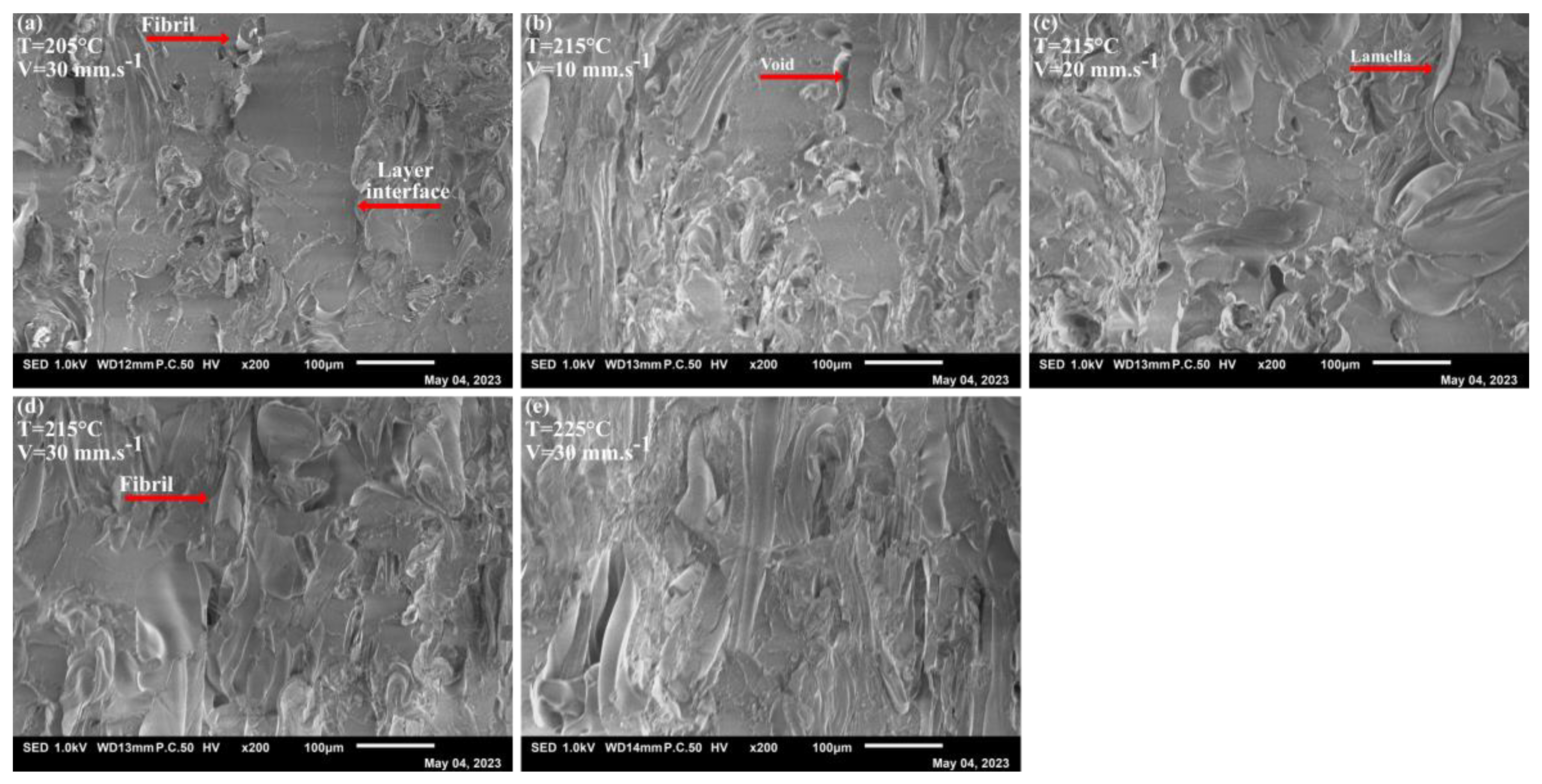
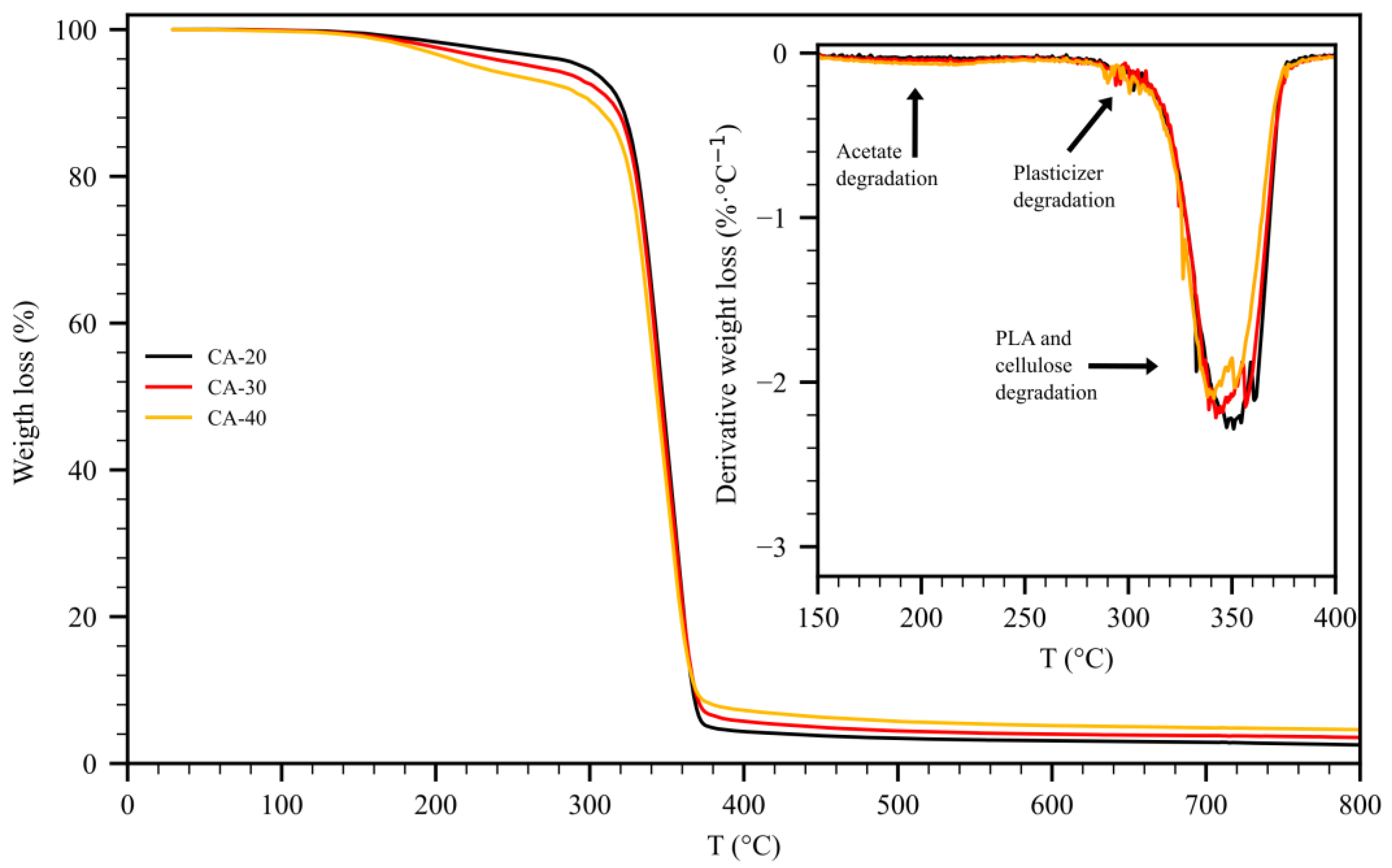


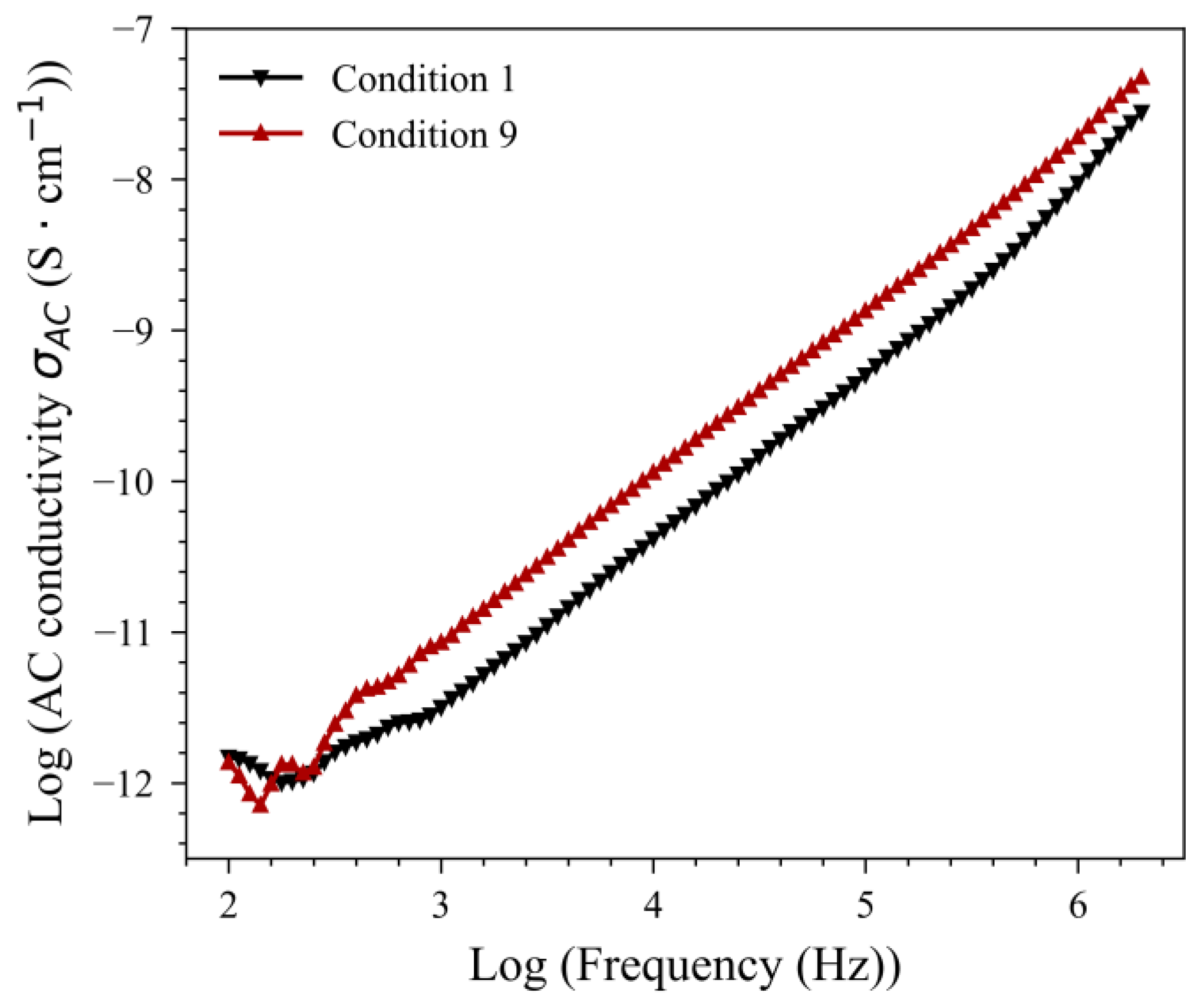
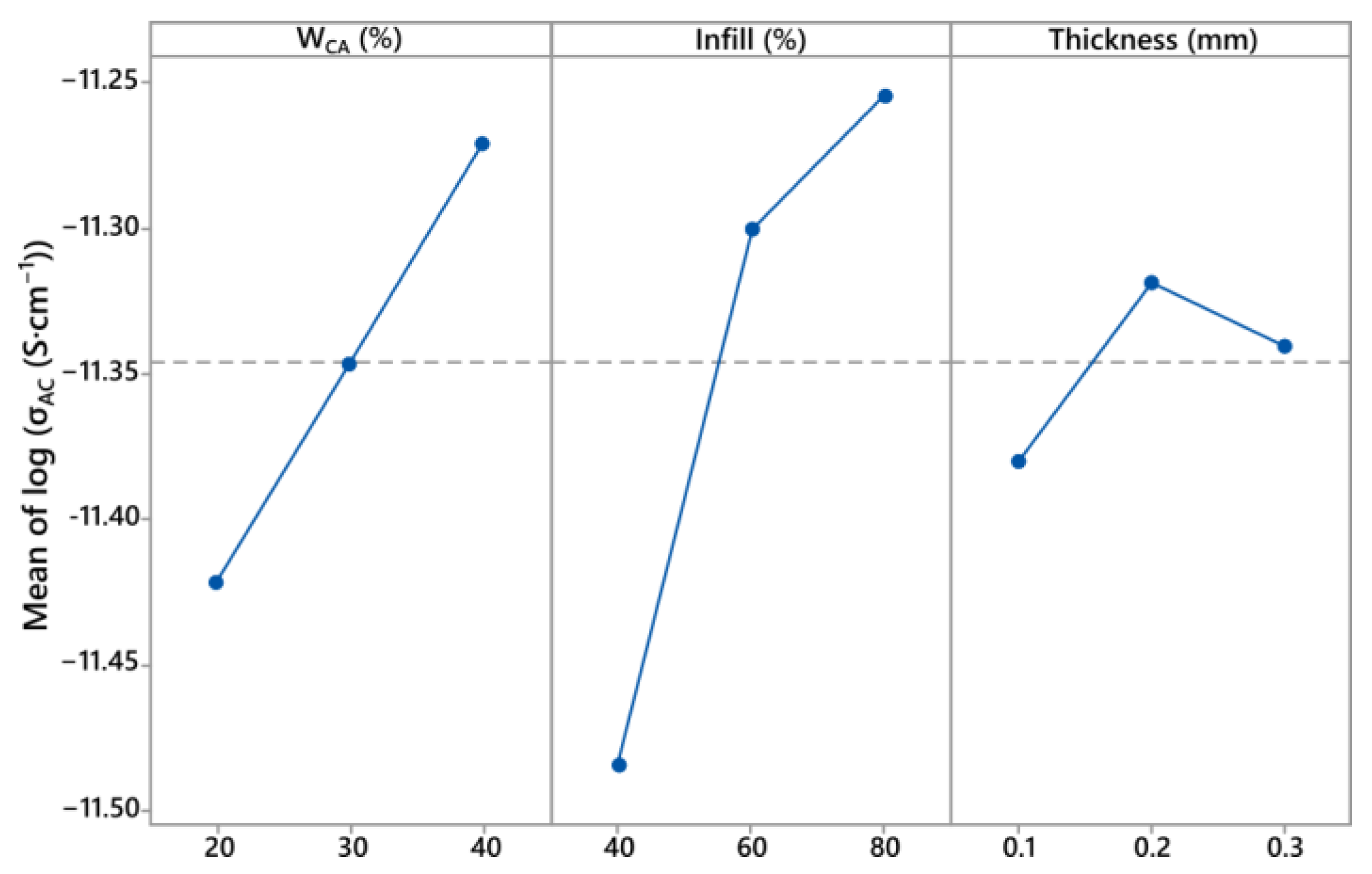
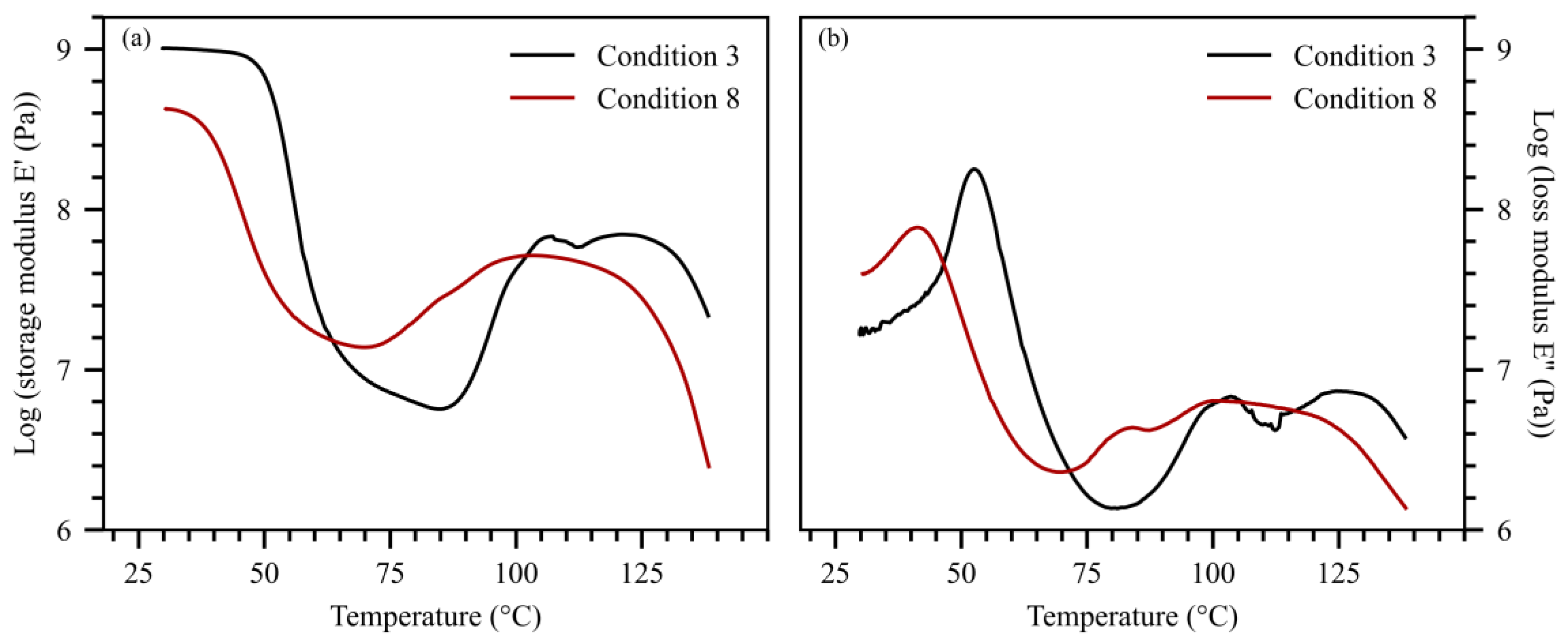

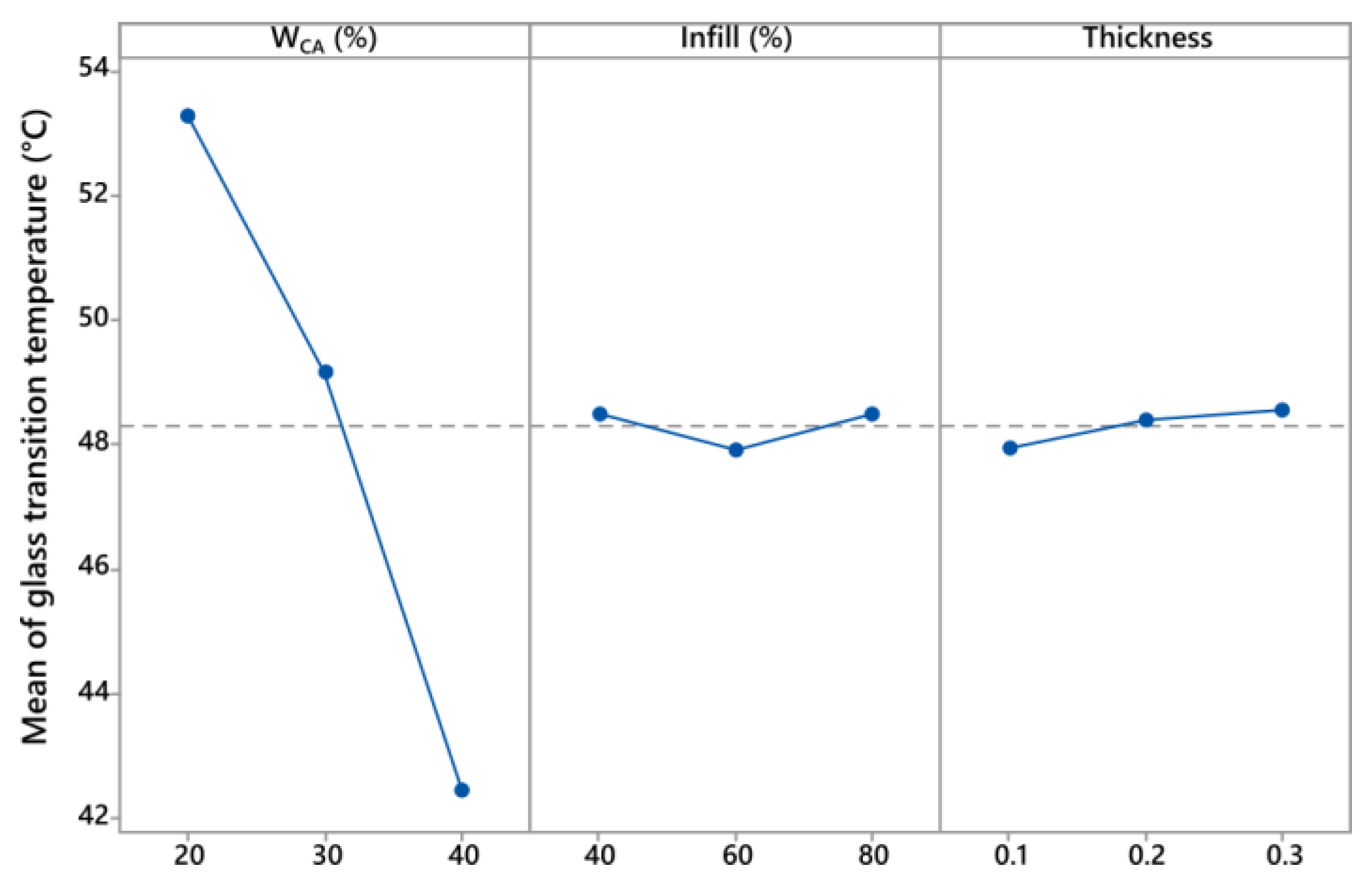
| Print Parameters | |||
|---|---|---|---|
| T nozzle ( °C) | 205 | 215 | 225 |
| Printing speed (mm·s−1) | 10 | 20 | 30 |
| Condition | WCA (%) | Infill Ratio (%) | Thickness (mm) |
|---|---|---|---|
| 1 | 20 | 40 | 0.1 |
| 2 | 20 | 60 | 0.2 |
| 3 | 20 | 80 | 0.3 |
| 4 | 30 | 40 | 0.2 |
| 5 | 30 | 60 | 0.3 |
| 6 | 30 | 80 | 0.1 |
| 7 | 40 | 40 | 0.3 |
| 8 | 40 | 60 | 0.1 |
| 9 | 40 | 80 | 0.2 |
| Condition | WCA (%) | Infill (%) | Thickness (mm) | ε′ @ 100 Hz | ε′ @ 10 kHz | ε′ @ 1 MHz |
|---|---|---|---|---|---|---|
| 1 | 20 | 40 | 0.1 | 1.91 ± 0.05 | 1.93 ± 0.06 | 1.90 ± 0.06 |
| 2 | 20 | 60 | 0.2 | 2.21 ± 0.02 | 2.23 ± 0.08 | 2.20 ± 0.01 |
| 3 | 20 | 80 | 0.3 | 2.32 ± 0.03 | 2.34 ± 0.04 | 2.30 ± 0.03 |
| 4 | 30 | 40 | 0.2 | 2.04 ± 0.03 | 2.06 ± 0.01 | 2.03 ± 0.01 |
| 5 | 30 | 60 | 0.3 | 2.31 ± 0.02 | 2.31 ± 0.02 | 2.27 ± 0.01 |
| 6 | 30 | 80 | 0.1 | 2.36 ± 0.03 | 2.37 ± 0.04 | 2.32 ± 0.03 |
| 7 | 40 | 40 | 0.3 | 2.11 ± 0.07 | 2.11 ± 0.07 | 2.07 ± 0.07 |
| 8 | 40 | 60 | 0.1 | 2.25 ± 0.04 | 2.25 ± 0.04 | 2.20 ± 0.04 |
| 9 | 40 | 80 | 0.2 | 2.46 ± 0.12 | 2.45 ± 0.11 | 2.39 ± 0.11 |
| Condition | WCA (%) | Infill (%) | Thickness (mm) | Log σac (S·cm−1) @ 1 kHz |
|---|---|---|---|---|
| 1 | 20 | 40 | 0.1 | −11.58 ± 0.03 |
| 2 | 20 | 60 | 0.2 | −11.36 ± 0.04 |
| 3 | 20 | 80 | 0.3 | −11.32 ± 0.04 |
| 4 | 30 | 40 | 0.2 | −11.45 ± 0.05 |
| 5 | 30 | 60 | 0.3 | −11.28 ± 0.04 |
| 6 | 30 | 80 | 0.1 | −11.30 ± 0.06 |
| 7 | 40 | 40 | 0.3 | −11.42 ± 0.06 |
| 8 | 40 | 60 | 0.1 | −11.26 ± 0.06 |
| 9 | 40 | 80 | 0.2 | −11.14 ± 0.07 |
| Condition | WCA (%) | Infill (%) | Thickness (mm) | E′ (MPa) | Tg PLA (E″ Peak, °C) |
|---|---|---|---|---|---|
| 1 | 20 | 40 | 0.1 | 694.4 | 53.5 |
| 2 | 20 | 60 | 0.2 | 805.8 | 53.1 |
| 3 | 20 | 80 | 0.3 | 976.8 | 53.3 |
| 4 | 30 | 40 | 0.2 | 692.2 | 49.0 |
| 5 | 30 | 60 | 0.3 | 774.6 | 49.4 |
| 6 | 30 | 80 | 0.1 | 877.4 | 49.1 |
| 7 | 40 | 40 | 0.3 | 656.2 | 43.0 |
| 8 | 40 | 60 | 0.1 | 424.6 | 41.3 |
| 9 | 40 | 80 | 0.2 | 654.1 | 43.1 |
| Dielectric Constant (ε′) Measured at 100 Hz | Storage Modulus (E′) Measured at 1 Hz | ||||||
|---|---|---|---|---|---|---|---|
| Polymer | T ( °C) | ε′ | Ref. | Polymer | T ( °C) | E′ (MPa) | Ref. |
| PLA:CA (40%) | 20 | 2.11 | Our Study | PLA:CA (40%) | 30 | 656 | Our Study |
| 2.25 | 425 | ||||||
| 2.46 | 654 | ||||||
| LDPE | Room T | 2.43 | [34] | LDPE | 30 | 380 | [35] |
| 2.21 | [36] | 390 | [37] | ||||
| HDPE | Room T | 2.48 | [34] | HDPE | 30 | 1710 | [37] |
| 2.5 | [38] | ||||||
| PP | Room T | 2.3 | [34] | PP | 30 | 1800 | [35] |
| 2.1 | [39] | 1816 | [40] | ||||
Disclaimer/Publisher’s Note: The statements, opinions and data contained in all publications are solely those of the individual author(s) and contributor(s) and not of MDPI and/or the editor(s). MDPI and/or the editor(s) disclaim responsibility for any injury to people or property resulting from any ideas, methods, instructions or products referred to in the content. |
© 2023 by the authors. Licensee MDPI, Basel, Switzerland. This article is an open access article distributed under the terms and conditions of the Creative Commons Attribution (CC BY) license (https://creativecommons.org/licenses/by/4.0/).
Share and Cite
Lecoublet, M.; Ragoubi, M.; Kenfack, L.B.; Leblanc, N.; Koubaa, A. How Do 3D Printing Parameters Affect the Dielectric and Mechanical Performance of Polylactic Acid–Cellulose Acetate Polymer Blends? J. Compos. Sci. 2023, 7, 492. https://doi.org/10.3390/jcs7120492
Lecoublet M, Ragoubi M, Kenfack LB, Leblanc N, Koubaa A. How Do 3D Printing Parameters Affect the Dielectric and Mechanical Performance of Polylactic Acid–Cellulose Acetate Polymer Blends? Journal of Composites Science. 2023; 7(12):492. https://doi.org/10.3390/jcs7120492
Chicago/Turabian StyleLecoublet, Morgan, Mohamed Ragoubi, Leonel Billy Kenfack, Nathalie Leblanc, and Ahmed Koubaa. 2023. "How Do 3D Printing Parameters Affect the Dielectric and Mechanical Performance of Polylactic Acid–Cellulose Acetate Polymer Blends?" Journal of Composites Science 7, no. 12: 492. https://doi.org/10.3390/jcs7120492






